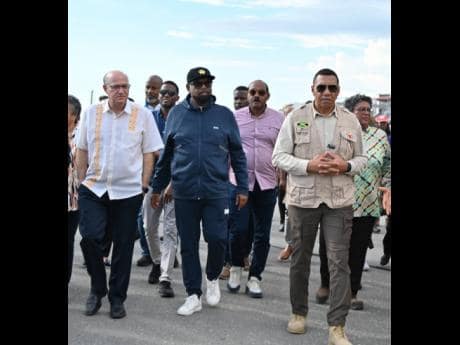
The visit to hurricane-ravaged western Jamaica last week by a muster of Caribbean Community (CARICOM) leaders was meant as a demonstration of regional solidarity.
But, beyond the symbolism, the presence of the heads of government – Gaston Browne, Antigua and Barbuda; Mia Mottley, Barbados; Dickon Mitchell, Grenada; Irfaan Ali, Guyana – served to highlight the value, and possibilities, of the regional integration movement, including how CARICOM, a 15-country regional organisation, might be further leveraged to the advantage of its members which exist in an increasingly environmentally dangerous part of the world.
In these circumstances, and with Jamaica focused on finding the resources to finance the reconstruction of the shattered west, it is timely, this newspaper believes, for a renewed and robust discussion on a five-year-old recommendation for the establishment of CARICOM-supported, but private sector-managed, growth and resilience bonds for precisely these kinds of events.
This new asset class would add to the other mechanisms in place, or in train, to help the region adapt to the worsening challenges of climate change, which is causing increasingly frequent extreme weather events.
Hurricane Melissa, a Category 5 storm, struck western Jamaica in late October with sustained winds of 185 mph. It damaged or destroyed over 135,00 homes, affecting nearly three-quarters of a million people. Public infrastructure, including roads, bridges, power and water facilities, schools and hospitals, were also badly impacted.
Initial estimates of the cost of the physical damage are at between 38 per cent and 47 per cent of GDP. Those figures, of course, will be much higher when the storm’s broader impact on the island’s economy is taken into account. Economic activity in western Jamaica, including in the island’s vital tourism industry, is largely at a standstill.
NOT CONFINED
In the Caribbean, and among CARICOM members, catastrophes like Melissa are not confined to Jamaica. During the 2024 Atlantic hurricane season, Hurricane Beryl, a Category 4 storm, cruised along Jamaica’s south coast, sideswiping the island. It caused substantial damage in some of the areas that have again been pummelled by Melissa.
But, before it brushed Jamaica, Beryl had, in the eastern Caribbean, slammed into Grenada, as well as caused significant damage to St Vincent and the Grenadines. In Grenada’s, case the cost was 100 per cent of GDP. In St Vincent, it was 17 per cent.
Unfortunately, these big hits by natural disasters to the small and fragile economies of CARICOM countries are not infrequent. In 2004, Hurricane Ivan, which also impacted areas of Jamaica, devastated Grenada. The cost of its damage was the equivalent of 200 per cent of the country’s GDP. Although a different class of catastrophe, the 2021 eruption of La Soufrière volcano in St Vincent cost 30 per cent of annual output.
But these are not the only devastating weather events from which CARICOM member states have suffered, especially in the last decade and a half.
For instance, a string of storms that hit Dominica in 2011 (Ophelia), 2015 (Erika) and 2017 (Maria) were used by a commission of experts to underline the logic, given the difficulty CARICOM states, in their straightened fiscal position would likely have affording insurance, of using regional growth and resilience bonds to build-back resiliently after these events.
The damage from the Dominica hurricanes cost, respectively, 40 per cent, 90 per cent and 220 per cent of the island’s economy.
JUMP-START
The commission chaired by the Barbadian economist Avinash Persaud was asked to suggest ways to jump-start the collective CARICOM economy.
“There is no tolerable level of insurance premium that would insure Dominica against losing 350 per cent of GDP every eight or so years,” the commissioners said in their report issued towards the end of 2020, in the midst of the COVID-19 pandemic. “… These are increasingly uninsurable risks.”
The best option in these circumstances, they argued, though more expensive upfront, was “building resiliently”. The intention would be to lessen the risk to, say, between two and 20 per cent of GDP, that would have to be “managed through contingent lending lines, like the IDB’s facility, parametric insurance like CCRIF, and the natural disaster clauses in Barbados and Grenadian government bonds”.
The policy aim would be to create a “resilience investment boom” as householders, with access to “low-cost, long-term loans”, build to new resilient standards.
Said the commissioners: “One of the key objectives of our proposed Growth and Resilience Bonds will be to create a pool of funding to finance these loans. We further propose to develop a CARICOM model Public Private Partnership (PPP) framework to identify and structure a regional portfolio of commercially viable projects that could be part-financed from the proceeds of Resilience and Growth Bonds.”
Some work has begun on similar ideas. Indeed, in addition to redeeming of global catastrophe bonds (US$150 million) and a payout (US$91.9 million) under its parametric insurance with the CCRIF, Jamaica has also received hurricane relief from the CARICOM Development Fund.
Recent events, however, emphasise the logic of new attention being paid to the Persaud Commission’s suggestio
Advertise with the mоѕt vіѕіtеd nеwѕ ѕіtе іn Antigua!
We offer fully customizable and flexible digital marketing packages.
Contact us at [email protected]


















In spite of the fact that the Jamaica Gleaner has offered more news worthy articles than any other Caribbean country’s news; it falls dismally short of coverage of news and analysis of Caribbean issues.
Having said that; I welcome this article in as much as the fact that such an important issue should not just be addressed as a single article.
The Gleaner would have to first recognize that Caribbean institutions are failing its people.
Some islands, Antigua and Barbuda fomost among them, thinks the solution is to be active in the COP and other international forums to advocate for debt forgiveness and infrastructure financing.
It’s a failure in the making evidence in Antigua is undergoing a road resurfacing supposably costing over $100 million EC. An infrastructure project that is being done so poorly that it could be all washed out in one hurricane.
The word “resiliency” is used but is not practiced.
Politicians making decisions about infrastructure is a failed practice.
Until the Caribbean news outlets with any credibility; partners with practical academics to point out the failures of politicians; and insist that policy recommendations like the commission’s recommendations be implemented; any talk of building resilience is a waste to Caribbean people who will be lifted vulnerable.
What see here is that politicians reach out to show support to their colleagues when their is destruction that render the economy nonfunctional to create the illusion that keeps the people under the politicians control.
Because the Jamaican prime minister still have to face reality after they leave. the task of seeking financing to repair infrastructure and homes lay with the prime minister of the country affected, so all this politicking is just performative politics.
Comments are closed.